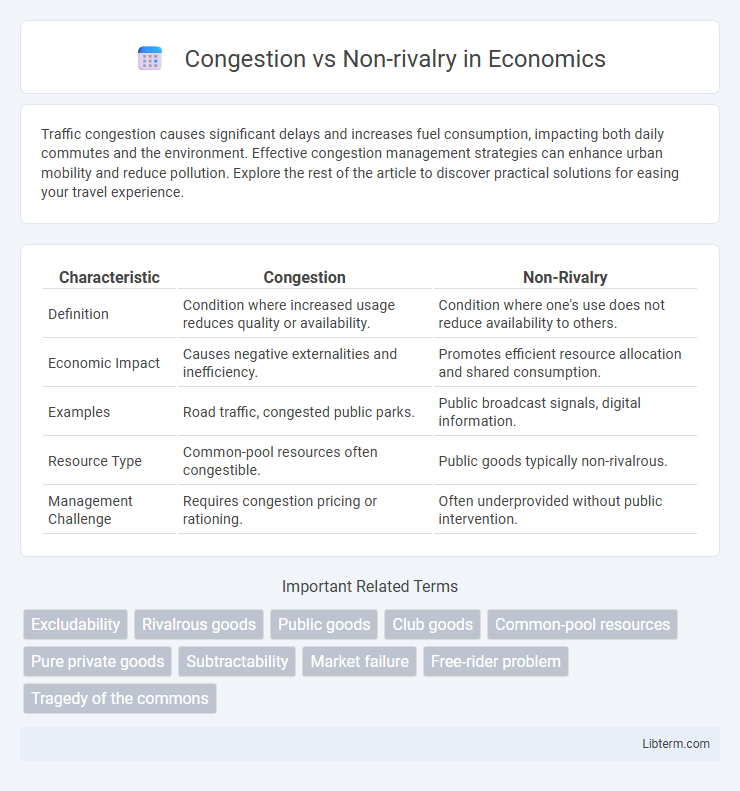Traffic congestion causes significant delays and increases fuel consumption, impacting both daily commutes and the environment. Effective congestion management strategies can enhance urban mobility and reduce pollution. Explore the rest of the article to discover practical solutions for easing your travel experience.
Table of Comparison
| Characteristic | Congestion | Non-Rivalry |
|---|---|---|
| Definition | Condition where increased usage reduces quality or availability. | Condition where one's use does not reduce availability to others. |
| Economic Impact | Causes negative externalities and inefficiency. | Promotes efficient resource allocation and shared consumption. |
| Examples | Road traffic, congested public parks. | Public broadcast signals, digital information. |
| Resource Type | Common-pool resources often congestible. | Public goods typically non-rivalrous. |
| Management Challenge | Requires congestion pricing or rationing. | Often underprovided without public intervention. |
Understanding Congestion: Definition and Examples
Congestion occurs when the demand for a resource exceeds its capacity, leading to decreased quality or availability, as seen in traffic jams or crowded internet networks. Non-rivalry describes goods or services that can be consumed by multiple users simultaneously without reducing availability, such as public broadcasts or digital software. Understanding congestion helps differentiate between rivalrous resources that degrade with overuse and non-rivalrous resources that remain unaffected by multiple users.
Defining Non-Rivalry in Economics
Non-rivalry in economics describes a good or service whose consumption by one individual does not reduce availability for others, exemplified by digital products like streaming services. Congestion occurs when a non-rival good's usage exceeds capacity, leading to diminished quality, such as overcrowded public Wi-Fi networks. Understanding non-rivalry helps differentiate between pure public goods and congestible goods, influencing efficient resource allocation and pricing strategies.
Key Differences Between Congestion and Non-Rivalry
Congestion occurs when the consumption of a good or service by one user reduces its availability or quality for others, often seen in traffic or internet bandwidth. Non-rivalry refers to goods that can be consumed simultaneously by multiple users without diminishing their availability, such as public broadcasts or digital content. The key difference lies in the exclusivity of use: congestion implies decreasing utility with increased usage, while non-rivalry ensures consistent utility regardless of the number of consumers.
Public Goods: The Role of Non-Rivalry
Non-rivalry in public goods means consumption by one individual does not reduce availability for others, allowing infinite shared use without congestion. When a good is truly non-rivalrous, such as national defense or a public flood warning system, its provision efficiently benefits all individuals simultaneously without depletion. Congestion occurs when non-rivalry breaks down, leading to diminished utility as more users consume the good, highlighting the importance of maintaining non-rivalrous characteristics for optimal public good provision.
Congestible Goods: When Usage Leads to Diminished Value
Congestible goods are a subset of non-rival goods where increased usage by individuals gradually reduces the overall value or quality experienced by others, such as public parks or highways during peak times. Unlike purely non-rival goods where one person's consumption does not affect another's, congestion introduces a threshold where excessive use leads to diminished utility. Managing congestion efficiently involves balancing accessibility with usage limits to sustain the value of these goods for all users.
Case Study: Roads as Congestible vs. Non-Rivalrous Resources
Roads illustrate the economic concepts of congestion and non-rivalry through their variable capacity and usage. When traffic volume exceeds road capacity, congestion occurs, causing delays and reducing overall utility, demonstrating roads as congestible goods. In contrast, non-rivalrous resources like digital content allow simultaneous consumption without diminishing availability, highlighting the distinct differences in resource allocation and efficiency challenges between congestible and non-rivalrous goods.
Market Efficiency: Impacts of Congestion and Non-Rivalry
Market efficiency is significantly affected by congestion, which occurs when demand exceeds the capacity of a resource, leading to increased costs and reduced accessibility for users. Non-rivalry, where one person's consumption does not diminish availability for others, enables efficient allocation and utilization of resources, particularly in digital goods and public infrastructures. Balancing congestion control with the benefits of non-rivalrous consumption promotes optimal resource distribution and maximizes overall welfare.
Policy Approaches: Managing Congestible and Non-Rival Goods
Policy approaches to managing congestible goods prioritize congestion pricing, capacity expansion, and demand regulation to mitigate overuse and maintain service quality. Non-rival goods require policies that sustain open access and address funding through public provision or subsidies, emphasizing broad usability without diminishing availability. Combining these strategies helps balance efficient resource allocation for congestible goods and equitable access for non-rival goods.
Real-World Examples of Congestion and Non-Rivalry
Road traffic congestion exemplifies congestion as increased use diminishes individual experience and efficiency, while public broadcasting services demonstrate non-rivalry because one person's consumption does not reduce availability for others. Urban park space often faces congestion during peak hours, reducing enjoyment due to overcrowding, in contrast to digital streaming platforms where simultaneous users do not deplete the service for others. Shared Wi-Fi bandwidth can become congested when too many devices connect, whereas knowledge resources like online encyclopedias exhibit non-rivalrous consumption as access is not limited by the number of users.
Future Implications: Technology, Sharing, and Resource Allocation
Congestion in network systems highlights the critical challenge of limited resource access, while non-rivalrous resources like digital content enable simultaneous use with minimal conflict. Future technology developments in blockchain and edge computing promise to optimize resource allocation, mitigating congestion by enabling decentralized and efficient sharing mechanisms. Emphasizing non-rivalrous digital goods promotes sustainable consumption models, transforming traditional infrastructure and economic frameworks toward more scalable and equitable systems.
Congestion Infographic

 libterm.com
libterm.com